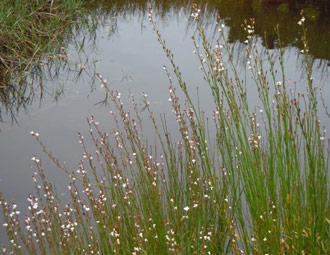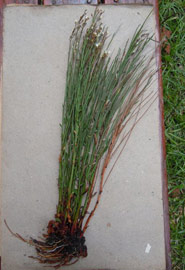Samolus porosus
Samolus porosus (L.f.) Thunb.
Family: Theophrastaceae
Common names: water-pimpernel
Introduction
Samolus porosus is a very adaptable herbaceous plant found growing in a variety of moist or wet habitats and often under harsh coastal conditions. It is potentially a very good plant for bog gardens, coastal gardens, pond edges, and moist rockeries in both full sunlight and light shade.

Description
Description
Samolus porosus is a tufted herbaceous perennial attaining an average height between 300 and 600 mm. It has stiff, erect stems that arise in tufts from horizontal rhizomes. Its stems are sparsely branched, ribbed, rough with little raised dots and slightly woody at the base.

The leaves are produced as a flat whorl at the base of the plant and there are smaller leaves arranged up the stem, often dying when the flowering stem is produced.

Its attractive flowers are small and white to pale pink, produced in racemes or panicles from November through to February.
Conservation Status
Status
Samolus porosus is endemic to South Africa where it is widespread, has no major threats and is therefore listed as Least Concern.
Distribution and habitat
Distribution description
Samolus porosus is a water loving plant found in moist or in permanently wet places in coastal marshes, seeps and cliffs from Namaqualand to KwaZulu-Natal.
Samolus porosus grows in clay and loamy soils in full sun, lightly shaded areas and even heavier shade. It is often found colonizing the edges of estuaries even where the water is subject to tidal influences and is therefore brackish. It may form dense colonies, and with its vigorous rhizomatous growth helps to stabilize water edges, thereby helping to reduce erosion.

It is also common on south-facing cliffs along the southern Western Cape coast where it latches onto mud flows or colonizes peaty crevices. In this environment it often grows as a single plant or as individuals scattered across the cliffs where it can find suitable purchase. These environments are shaded and only receive short periods of direct sunlight, particularly in summer. Samolus porosus, in this environment, grows softer reaching for better light, and although initially erect, its etiolated stems often cascade from the cliffs.
Samolus porosus grows wherever there is permanent seep and has the habit of colonizing erosion or drainage ditches where water accumulates. It may be found in such ditches along forest margins where it produces an abundance of soft, tangled and cascading branches. When these plants are flowering they look very similar to Gypsophila paniculata , the florist plant commonly known as baby's-breath.
Derivation of name and historical aspects
History
Samolus = a genus of about a dozen species of water loving herbs found almost anywhere in the world, commonly called brook weed or water pimpernel. The source of the name is unclear.
The specific epithet porosus has its derivation from the Greek word poros, a passage or pore, and therefore porosus means having minute interstices or openings through which water and air may pass.
Ecology
Ecology
Although water loving, this plant is adapted to surviving adverse conditions. Samolus porosus is, from time to time, subject to drought and then the leaves die to a crisp papery remnant. The plant in general will look rather scrappy, but it is kept alive by the rhizomatous roots and stems in the ground. The plant waits for wetter conditions and then resprouts vigorously.
Uses
Use
Although there are no recorded economic uses, Samolus porosus has horticultural potential.

Growing Samolus porosus
Grow
Samolus will grow well in any position in sun or partial shade as long as it is well watered. It will be a very useful plant for bog gardens, coastal gardens, stream edges or even a well watered pot in semishade where it can cascade over the edge of the pot and give a good display when flowering.
The quick and easy way to propagate this plant is by division. Clumps can be dug up and split or cut into smaller sections and planted straight into soil and kept moist.
Samolus porosus, however, produces copious amounts of seed in summer. Each flower produces a small capsule that releases very fine seed in January or February. This seed should be sown fresh within the first year to ensure good germination. At Kirstenbosch we took the extra precaution of smoking the seed with good results. Young seedlings are pricked out into individual plugs or pots and fed regularly with an organic fertilizer. At Kirstenbosch we have only recently worked with this plant and are still experimenting with suitable soil mixes. Early indications are that it is adaptable to most soils as long as it is regularly watered.
References
- Goldblatt, P. & Manning, J.C. 2000. Cape plants. A conspectus of the Cape Flora of South Africa. Strelitzia 9. National Botanical Institute, Pretoria and Missouri Botanical Garden.
- Kidd,Maytham, M. 1996. Cape Peninsula. South African Wild Flower Guide 3. Botanical Society of South Africa, Cape Town.
- Kesting, D. 2001. Wild flowers of the Cape Peninsula. Botanical names: origins and meanings. Friends of the Silvermine Nature Area, St James, Cape Town.
- Moriarty,A . & Snijman,D. 1996. Outeniqua Tsitsikamma & Eastern Little Karoo. South African Wild Flower Guide 2. Botanical Society of South Africa, Cape Town.
- Trinder-Smith,T. 2006. Wild flowers of the Table Mountain National Park . South African Wild Flower Guide 12. Botanical Society of South Africa, Cape Town.
Credits
Melissa Van der Burg and Anthony Hitchcock
Kirstenbosch Garden,GKBC/NN
March 2012
Plant Attributes:
Plant Type: Shrub
SA Distribution: Eastern Cape, KwaZulu-Natal, Western Cape
Soil type: Clay, Loam, Brack/saline
Flowering season: Early Summer, Late Summer
PH: Acid, Alkaline, Neutral
Flower colour: White, Pink
Aspect: Full Sun, Morning Sun (Semi Shade), Afternoon Sun (Semi Shade)
Gardening skill: Easy
Special Features:
Horticultural zones








Rate this article
Article well written and informative
Rate this plant
Is this an interesting plant?
Login to add your Comment
Back to topNot registered yet? Click here to register.